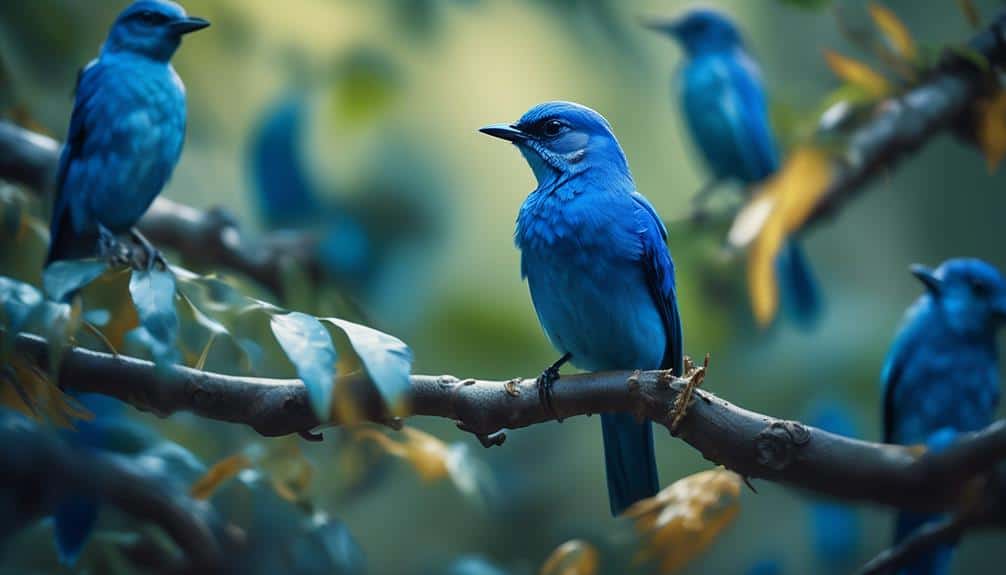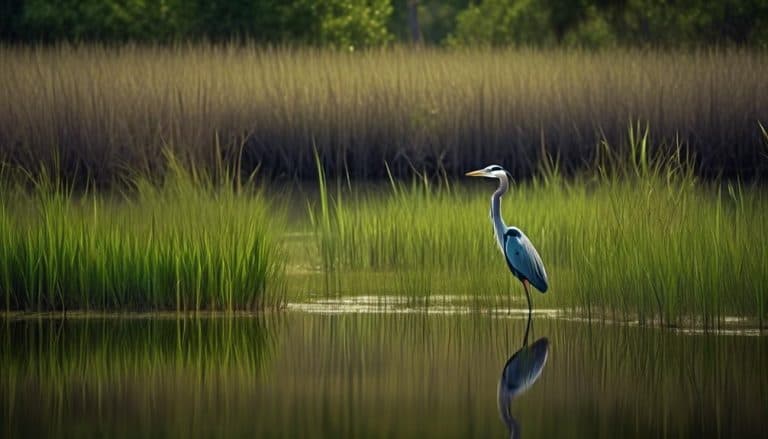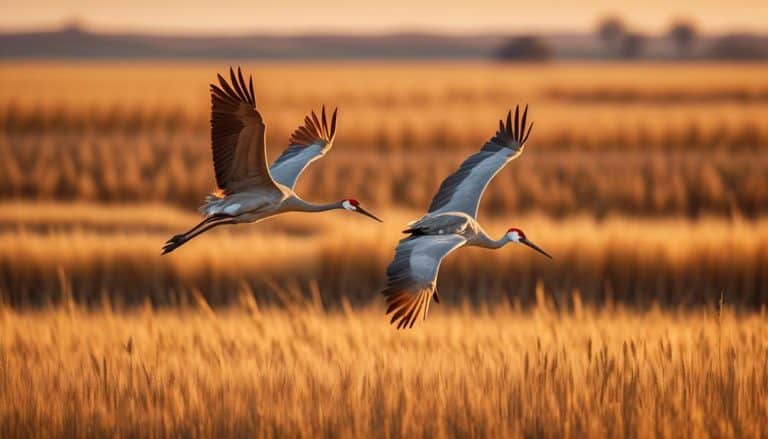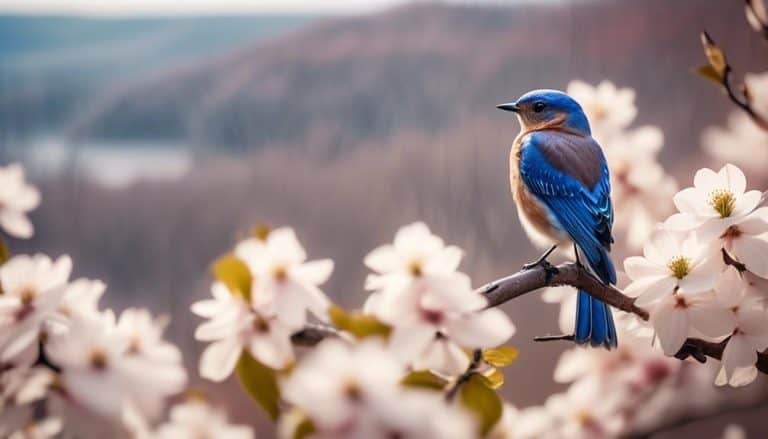As the saying goes, 'birds of a feather flock together.' And when it comes to the blue birds of North Carolina, there is certainly no shortage of diversity. From the Eastern Bluebird to the Indigo Bunting, these vibrant creatures add a splash of color to the picturesque landscapes of the state.
But what other species can be found in this region? Well, my fellow bird enthusiasts, prepare to be intrigued, for there are a few more surprises in store. So, let's embark on a journey through the blue-hued avian world of North Carolina, and uncover the hidden gems that await us.
Eastern Bluebird

The Eastern Bluebird is a small, colorful bird that's commonly found in North Carolina. Its habitat preferences are diverse, as it can be found in a variety of environments, including open woodlands, fields, and meadows. It prefers areas that have scattered trees or perches for hunting insects and small fruits.
Eastern Bluebirds are cavity nesters, meaning they seek out pre-existing holes in trees or nest boxes for breeding. They're known to be monogamous and form strong pair bonds during the breeding season. Male bluebirds are responsible for finding suitable nesting sites and attracting females with their vibrant plumage and melodious songs.
Once a pair has formed, the female takes charge of building the nest, which is made of grass, leaves, and pine needles. The female then lays a clutch of 3-7 pale blue eggs, which she incubates for about 12-14 days. Both parents share the responsibility of feeding the chicks until they fledge, which usually occurs after 16-21 days.
The Eastern Bluebird is a fascinating species with unique habitat preferences and interesting nesting behavior, making it a beloved bird among birdwatchers in North Carolina.
Indigo Bunting
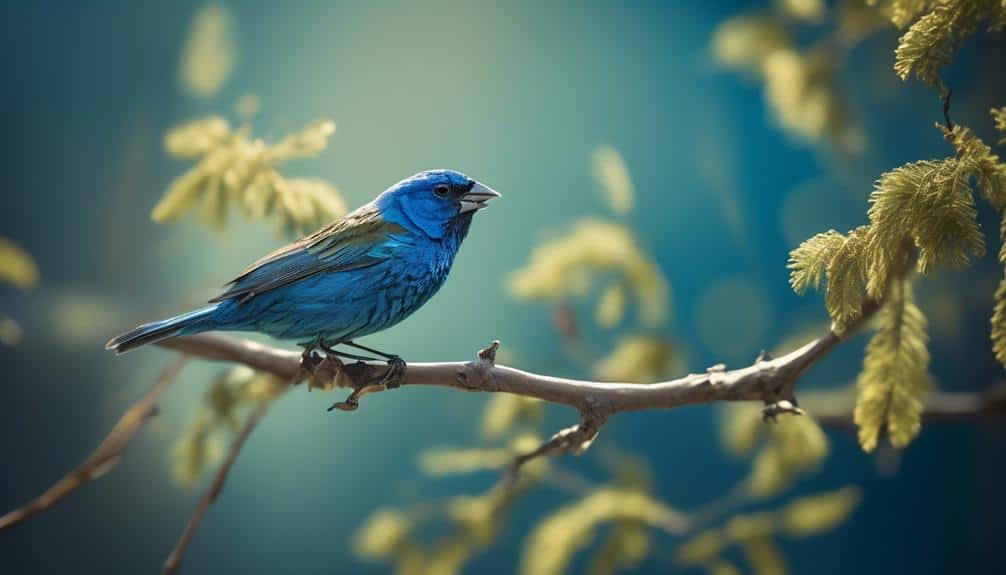
After exploring the nesting behavior of the Eastern Bluebird, it's intriguing to shift our focus to the Indigo Bunting, another captivating bird species found in North Carolina.
The Indigo Bunting, scientifically known as Passerina cyanea, is a small, brightly colored songbird that belongs to the Cardinal family. This species is known for its stunning indigo blue plumage, which is more vibrant in males compared to females.
Breeding habits of the Indigo Bunting are fascinating. These birds are primarily monogamous, with males attracting females through their vibrant blue colors and melodious songs. Their breeding season starts in late spring and extends into summer. The females build cup-shaped nests made of grass, leaves, and bark, which are usually hidden in dense shrubs or trees. They lay around 3-4 eggs, and both parents take turns incubating them for about 12-13 days.
When it comes to migratory patterns, Indigo Buntings are neotropical migrants. They spend their winters in Central and South America, and then migrate northward to breed in North America during the warmer months. These birds undertake long-distance journeys, covering thousands of miles each year. They navigate using celestial cues and landmarks, making their way back to their breeding grounds in North Carolina and other parts of the United States.
Blue Grosbeak
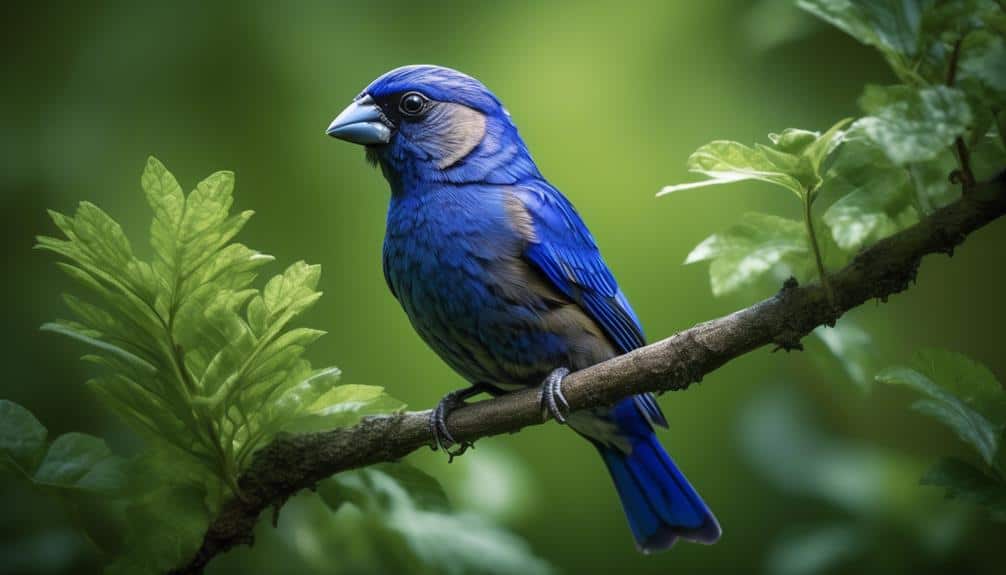
Blue Grosbeaks, scientifically known as Passerina caerulea, are striking bird species found in North Carolina known for their vibrant blue plumage and distinctive beak. The Blue Grosbeak's habitat primarily consists of open woodlands, brushy areas, and scrublands with dense vegetation. They prefer habitats near water sources such as rivers, streams, and wetlands. These birds can also be found in agricultural fields and grasslands.
In terms of migration patterns, Blue Grosbeaks are partially migratory birds. Some individuals migrate to southern Mexico and Central America during the winter, while others remain in North Carolina year-round. The migration of Blue Grosbeaks is influenced by factors such as food availability and weather conditions.
During the breeding season, male Blue Grosbeaks showcase their vibrant blue plumage and sing beautiful songs to attract mates. Females, on the other hand, have a more subdued appearance with brown feathers. They build cup-shaped nests in shrubs or low trees, using materials such as grass, twigs, and leaves.
Mountain Bluebird
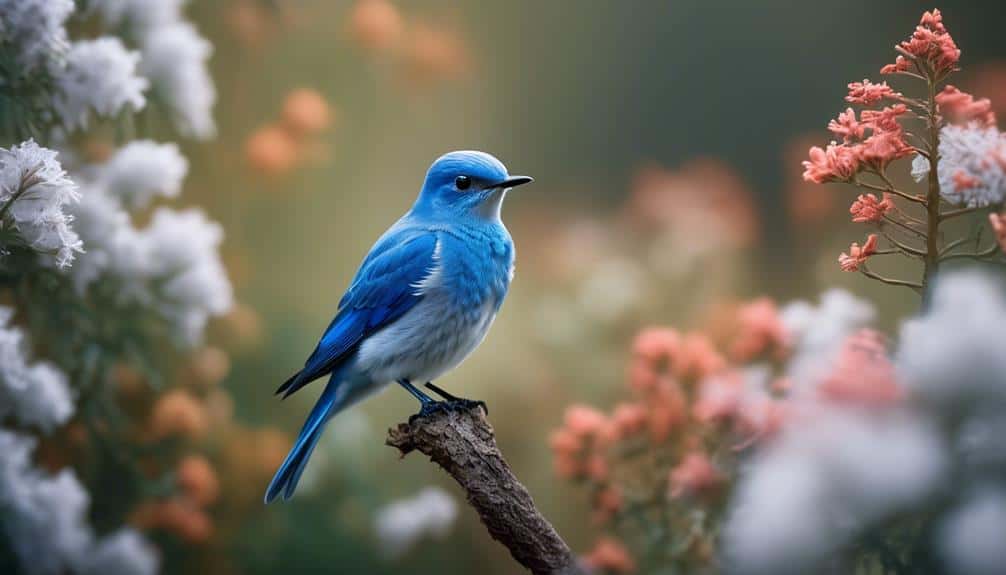
With its vibrant plumage and graceful flight, the Mountain Bluebird is a captivating bird species found in North America. As an avid bird watcher, I've been fortunate enough to observe these magnificent creatures in their natural habitat.
Here are some fascinating facts about the Mountain Bluebird:
- Migration Patterns: Mountain Bluebirds are known for their extensive migration patterns. They breed in the northern parts of North America, including Alaska and Canada, and during the winter months, they migrate to the southern parts of the United States and Mexico. This long-distance migration allows them to find suitable habitats and avoid harsh weather conditions.
- Habitat Requirements: Mountain Bluebirds prefer open grasslands and meadows with scattered trees for nesting. They require nest boxes or tree cavities for breeding and are often found in areas with short grasses and low shrubs. These habitats provide them with easy access to insects, their primary food source. Additionally, they prefer areas with little human disturbance and minimal competition from other bird species.
- Nesting Behavior: Mountain Bluebirds are cavity nesters, meaning they nest in pre-existing holes in trees or nest boxes. They're known to be highly territorial during the breeding season and will fiercely defend their nesting sites from intruders. The female typically lays a clutch of 4-7 light blue eggs and incubates them for about two weeks. Both parents participate in raising the chicks until they fledge.
- Conservation Status: Despite their captivating beauty, Mountain Bluebirds face certain conservation challenges. Loss of suitable habitat due to urbanization and agricultural practices, as well as competition for nesting sites with non-native bird species, have impacted their populations. Efforts to provide nest boxes and protect their preferred habitats have been crucial in their conservation.
Observing the Mountain Bluebird in its natural habitat is truly a remarkable experience. Its vibrant plumage, coupled with its fascinating migration patterns and habitat requirements, make it a remarkable species worth protecting. By understanding and appreciating these aspects of the Mountain Bluebird's life, we can contribute to its conservation and ensure that future generations can continue to enjoy their beauty.
Cerulean Warbler
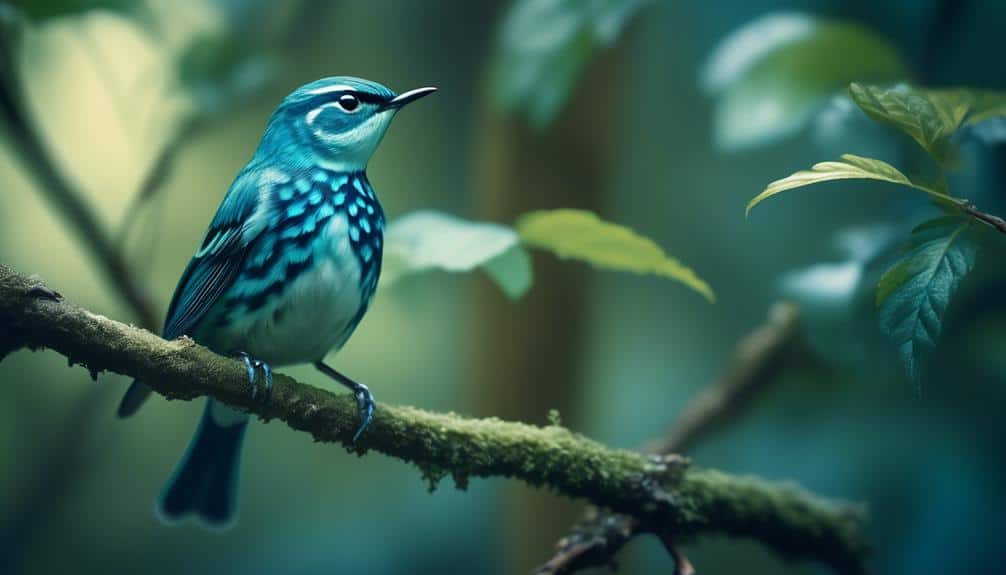
The Cerulean Warbler, a small migratory songbird, is known for its striking blue coloration and unique breeding habits. This beautiful species is a priority for conservation efforts due to its declining population and habitat loss. To understand the importance of these efforts, it is crucial to examine the habitat preferences and conservation strategies for Cerulean Warblers.
Cerulean warblers prefer mature deciduous forests with a dense canopy and a well-developed understory. They tend to inhabit areas with a high diversity of tree species, such as oak, hickory, and maple. These forests provide the necessary conditions for the birds to find suitable nesting sites and ample food sources, mainly consisting of insects and caterpillars.
Conservation organizations have been working diligently to protect and restore the Cerulean Warbler's habitat. By implementing measures such as forest management practices, reforestation projects, and land acquisition, they aim to ensure the long-term survival of this species. The table below highlights some of the ongoing conservation efforts:
| Conservation Efforts | Description |
|---|---|
| Forest Management | Sustainable practices to maintain suitable habitat conditions for Cerulean Warblers. |
| Reforestation Projects | Planting native tree species to restore and expand their preferred habitat. |
| Land Acquisition | Purchasing and protecting land to conserve critical breeding and stopover sites. |
Through these conservation efforts, we can hope to reverse the decline of the Cerulean Warbler population and ensure their continued presence in North Carolina's forests. By protecting their habitat, we not only safeguard this beautiful species but also contribute to the overall health and biodiversity of our ecosystems.
Frequently Asked Questions
What Is the Average Lifespan of a Blue Grosbeak?
The average lifespan of a blue grosbeak is around 5-7 years. They are known for their elaborate breeding behavior, including courtship displays and building nests in shrubs or low trees.
How Does the Cerulean Warbler Differ in Appearance From Other Blue Birds in North Carolina?
The Cerulean warbler stands apart from its blue bird counterparts in North Carolina with its distinctive appearance. Its vibrant blue color, coupled with its unique black necklace and white undersides, make it easily distinguishable in the avian world.
What Is the Preferred Habitat of the Indigo Bunting?
The preferred habitat of the indigo bunting includes open woodlands, brushy areas, and edges of fields. They are known for their breeding habits, which involve building nests in shrubs or low trees.
Are There Any Threats to the Population of Mountain Bluebirds in North Carolina?
Yes, there are threats to the population of mountain bluebirds in North Carolina. Loss of habitat, climate change, and predation are some factors. Conservation efforts focus on protecting nesting sites and promoting habitat restoration.
Can the Eastern Bluebird and the Indigo Bunting Be Found in the Same Regions of North Carolina?
Yes, the Eastern bluebird and the indigo bunting can be found in the same regions of North Carolina. Their distribution overlaps due to similar habitat preferences, making it possible for them to coexist.
Conclusion
After exploring the diverse avian world of North Carolina, it's clear that these blue birds possess an ethereal beauty that captivates the beholder.
From the vibrant Eastern Bluebird, with its celestial blue plumage, to the enchanting Indigo Bunting, resembling a sapphire gem in flight, these feathered wonders grace our skies with their celestial presence.
The Blue Grosbeak, a true azure marvel, and the Mountain Bluebird, a symbol of untamed wilderness, further add to the tapestry of blue hues.
Lastly, the delicate Cerulean Warbler, like a fleeting whisper of cerulean magic, completes this avian symphony.

